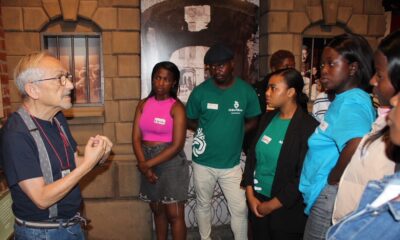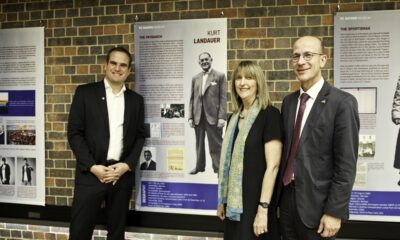
Featured Item
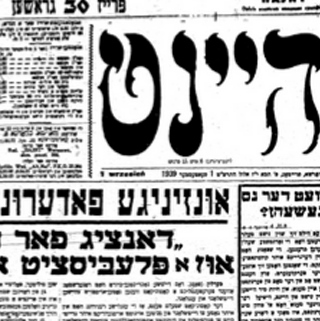
Yiddish paper beloved by Polish Jewry of old
ANT KATZ
Haynt was a Polish daily newspaper published in Yiddish between 1908 and 1939. Its editors were : Shmuel Yankev Yatskan (1908-1920); Abraham Goldberg; Aharon Einhorn; Chaim Finkelstein; Yitzhak Gruenbaum.
Haynt’s weekend edition had special sports, arts, and women’s interest supplements.
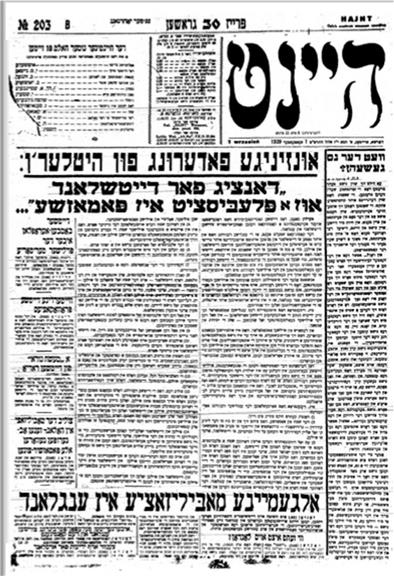 A peek through its issues reveals what was important to Polish Jews at the time – world news, politics, literature, reports from small towns, and, yes, face cream.
A peek through its issues reveals what was important to Polish Jews at the time – world news, politics, literature, reports from small towns, and, yes, face cream.
RIGHT: The last edition of Haynt in September 1939
Haynt appealed to Jews of all stripes: Zionists, Bundists, Orthodox and secular. Alongside news, what we might today call “lifestyle columns,” appeared in depth.
One 1929 piece called “gut yontef,” reported on all of the different ways Jews greet each other on religious holidays.
In the words of its last editor, Chaim Finkelstein, “Haynt was constantly speaking up for Jewish interests, ceaselessly calling for rights for Jews.”
Its last issue was published on erev Yom Kippur 1939, one week before Poland was invaded by Nazi troops.
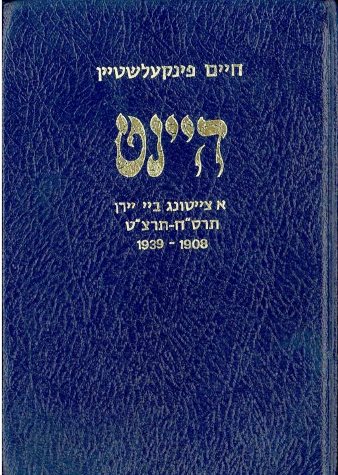
LEFT: The Yiddish newspaper was consumed with relish by Polish Jewry before the war – see below how to access archive copies on the web
The HISTORICAL JEWISH PRESS website has 8,904 Issues with 59,100 pages published between 1915 and 1939 available to view.
The material is maintained by the National Library of Israel on microfilm is in a fair condition.
There are various problems with tearing, blurred print, stains, and black streaks.
Some of these problems stem from the newspaper’s original printing, while others are a result of the copies’ storage conditions.
There is also a HAYNT WEBSITE
SEE PICS, CARTOONS & OLD ADS BELOW STORY
Haynt’s history: Prof Avraham Novershtern
Haynt (‘Today’, 1908–1939), was one of the two daily newspapers, the other being Der moment (‘The Moment’, 1910–1939), which embody the impressive development of the Yiddish press in Eastern Europe in general and in Poland specifically. These two publications filled a crucial rôle in the rise of Warsaw as one of the centres of modern Jewish culture in the Twentieth Century, up until the Holocaust.
The origins of Haynt were humble; the newspaper was a late outcome of the Revolution of 1905 in Tsarist Russia. One of the results of the revolution was a considerable easing of the restrictions on publication of newspapers of all types and languages, despite the fact that the press continued to suffer from considerable legal limitations, most particularly, censorship.
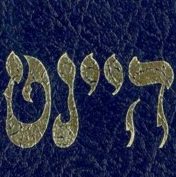 The reforms cleared the way for the development of the Yiddish press, which suffered especially from the obstacles that the authorities placed in its way. Only in 1903 did the first daily newspaper in Yiddish appear in Tsarist Russia; two years later, in 1905, the first Yiddish daily newspaper was published in Warsaw as the ‘younger sibling’ of the Hebrew papers that had previously been printed — Ha-tsefirah and Ha-tsofeh. The dramatic events that took place in the year of the revolution and in its aftermath — first and foremost, the wave of pogroms—increased significantly the thirst for current news.
The reforms cleared the way for the development of the Yiddish press, which suffered especially from the obstacles that the authorities placed in its way. Only in 1903 did the first daily newspaper in Yiddish appear in Tsarist Russia; two years later, in 1905, the first Yiddish daily newspaper was published in Warsaw as the ‘younger sibling’ of the Hebrew papers that had previously been printed — Ha-tsefirah and Ha-tsofeh. The dramatic events that took place in the year of the revolution and in its aftermath — first and foremost, the wave of pogroms—increased significantly the thirst for current news.
The founder of Haynt, Shmuel Yankev Yatskan (1874–1936), received an extensive traditional Jewish education before entering the world of journalism, where he gained much experience in the Hebrew-language press. Inspired by the dramatic events of 1905–1906, he envisioned the possibility of publishing a daily newspaper in Yiddish at an affordable price, much like other similar publications in Russian and in Polish. In 1906, he founded the daily Yidishes tageblat (1906–1911), which immediately attracted a broad audience and lasted until the beginning of 1911.
Finkelshteyn brothers
His partners in its publication were the Finkelshteyn brothers; owing to their success with the Yidishes tageblat, they began in 1908 to publishHaynt, which quickly became the most widespread Yiddish newspaper in Eastern Europe. Abraham Goldberg (1881–1933) served for many years as the managing editor and, later, became its editor-in-chief. Some sources claim that, at its peak, the newspaper reached a circulation of one hundred thousand copies, but it is reasonable to assume that these numbers are grossly inflated.
Throughout the 1930s, Haynt apparently printed around twenty-five thousand copies, but one must note that its readership was significantly larger than the number of copies sold, especially considering the extreme poverty that affected a considerable part of Poland’s Jewry—for whom the purchase of a newspaper issue was considered a luxury.
The editor Yatskan sought from the start to present Haynt as a newspaper appealing to an audience as wide as possible. On the one hand, it attracted a sizeable portion of the best writers of the generation, who contributed to the newspaper at one or another time in their lives: Sholem Aleichem (1859–1916) published in Haynt the novel Der blutiker shpas (‘The Bloody hoax’) and the second series of Menahem-Mendl letters, as well as other works. Isaac Leib Peretz (1852–1915) also contributed feuilletons and stories to the newspaper. The prominent writers for the newspaper during its early years (up until the First World War) included, among others, Hillel Zeitlin (1871–1942), David Frishman (1859–1922), Sholem Asch (1880–1957) and Hirsch David Nomberg (1876–1927). Some of them continued to play an important and central rôle in the newspaper also during the Interwar period.
Contributors switched between papers
The close competition between Haynt and Der moment meant that, sometimes, well-known contributors (such as Hillel Zeitlin) switched from one paper to the other, a dramatic step that, during the period between the two world wars, made waves throughout the Polish Jewish world. Such was the case, for example, with B Ye`ushzohn (born Moyshe Bunem Justman, 1889–1942), who was the most popular journalist of that time, owing to his style, which appealed to all readers and which recalled the language and the spirit of traditional texts. In 1925, he made the move from Der moment to Haynt, drawing with him legions of his loyal readers.
The physical dimensions of the newspaper during its early years were fairly limited—only four to six pages daily; even during its later phase in the Interwar period, the newspaper issues published on weekdays usually comprised eight to ten pages, while those appearing on the eve of the Sabbath and holidays were larger. Within these quantitative limits, the newspaper attempted to include a very wide variety of material—news, articles on current events by noted writers, literary works, economic news, and information on cultural life. It also paid special attention to news relating to the city of Warsaw itself, including both Jewish and general themes. Therefore, the materials included in the newspaper makes it one of the inexhaustible sources of information for understanding the daily life of Polish Jews in general and the Warsaw Jewish community in particular.
One of the central factors contributing to the great popularity of Haynt (and also of its competitors) was its publication of serialised novels of a sensational nature, namely, those termed shundromanen (‘trash novels’) in Yiddish, the equivalent of ‘trashy romance novels’ in English. They usually appeared anonymously, since their authors were ashamed to be associated with them.
Haynt appealed to a wide array of readers
Frequently, these shundromanen were actually re-workings of foreign-language originals, with certain adaptations in order to apply the storyline to a Jewish setting. Some of them reflected the style of a detective novel and described the ‘dark corners’ of a big city and, especially, the shady underworld. Some shundromanen included mildly erotic scenes in their plots. During the 1920s, these serialised novels vanished gradually from the pages of the newspaper; however, they continued to enjoy a prominent place in the paper Hayntike nayes (‘Today’s news’, 1929–1939), a popular afternoon tabloid that was published by the owners of Haynt with the intention of competing with other sensationalist newspapers that appeared in Yiddish and in Polish.
Due to their publication of these shundromanen and also owing to the way in which they presented the news (in particular during the early years), part of the Jewish intelligentsia put Haynt and Der moment in the category of yellow press.
One must recall that Haynt appealed to a very wide array of readers from all walks of life: Observant and traditional Jews of all kinds were among its readers (even if they did so from time to time surreptitiously), as were secular Jews (who were also spread out across a diversity of backgrounds and opinions), Zionists, and ‘ordinary’ Jews. The editors were aware of this and made every effort to address the broadest common denominator possible, which, often enough, was somewhat low.
With the outbreak of the First World War, the first phase of the newspaper’s life came to an end. The years of the war in which Warsaw fell under German occupation were a nadir in the paper’s existence: it shrank to barely more than a publication of news alone (which, of course, underwent heavy censorship) and almost completely ceased publishing literary material. The circulation of Haynt also shrank drastically during this time, for it was no longer able to reach those readers who lived in territories under Russian rule.
Heavy censorship felt in this period
The establishment of an independent Poland inaugurated a new era for the Jewish press, including Haynt. In those years, Yatskan left his position as the chief editor and was replaced by Abraham Goldberg, a journalist with Zionist convictions, who was personally close to Yitzhak Gruenbaum.
The heavy hand of censorship was strongly felt throughout this period. The authorities often confiscated issues of the newspaper under various pretexts, but it persevered by appearing under a variety of disguised names. Between 1920 and 1925, it was called Nayer haynt (‘New today’); for a while, it was also published under the name Der tog (‘Today’)—a cover name for Haynt that its publishers used whenever it became necessary and until the newspaper could again be published under its widely popular name.
In the twenty years between the two world wars, the Jewish population of Poland underwent accelerated processes of modernisation, while also suffering from rising impoverishment, from deepening anti-Semitism, and from the feeling of suffocation in the absence of positive perspectives.
The newspaper reflected and expressed these developments; its tone became more ideological and more aggressive. Haynt identified itself unequivocally with the Zionist movement and served as a host for the writings of its leaders—Abraham Ozjasz Thon (1870–1936), Yitzhak Gruenbaum (1879–1970), Naḥum Sokolow (1859–1936; sometimes his articles were translated from Hebrew), Moshe Kleinbaum (later, Moshe Sneh, 1909–1972), and others.
SEE PICS, CARTOONS & OLD ADS BELOW STORY
This stance also reflected the fact that other ideological movements within Polish Jewry—including the Orthodox community, the Bund, and the socialist Zionists (during the 1930s)—established their own daily newspapers. Nevertheless, Haynt did not become a clear-cut political organ; rather, it served as the voice of the Zionist mainstream, in opposition to its rival Der moment, which, during its later years, was taken over by the Revisionist Zionists. These two newspapers both devoted considerable space to the events taking place in Palestine and to the Jewish communities of the world.
The literary content of Haynt continued to grow more diverse in the 1920s and 1930s, during which it published the novels of popular Yiddish authors, such as the works of Sholem Asch, Israel Joshua Singer (1893–1944), and others. Likewise, it began to print a literary page, which included articles and news on the developments in Yiddish, Hebrew and world literature. This page sometimes included works by Yiddish poets (such as Itzik Manger, 1901–1969). One of the most popular sections in Haynt (like with other Yiddish newspapers) was its humour page. It also regularly published popular articles relating to medicine and health. Menahem Kipnis (1878–1942) covered the field of music, in all of its forms, from liturgical music to opera performances in Warsaw, and his articles and items of information are a vast source for research on this aspect of Jewish life in Poland. At times,Haynt also published a column aimed at women, although it is clear that the newspaper primarily targeted a male audience. Women did not have a substantial presence on the publication’s diverse staff of writers, which, at its height, comprised dozens of contributors working on a full-time or part-time basis — including members of the editorial board and writers in Poland and abroad. One of the most prominent contributors to Haynt during the 1930s was Azriel (Esriel) Carlebach (1909–1956), who later became the editor of the Israeli daily Maʿariv (1948–present).
Increasing linguistic assimilation, as well as the economic crises that hit the Jewish population of Poland particularly hard, jeopardised the continued existence of the newspaper. Despite the fact that the space set aside for commercial advertisement continued to grow over the years, it never amounted to a substantial portion of the newspaper. One of the main sources of income for Haynt was family obituaries and advertisements for theatre performances and cultural events, which reflect the rich cultural life of Warsaw Jews.
In 1932, Haynt was transferred from private ownership to the hands of a co-operative owned by the members of the printing and journalism staffs. This co-operative succeeded by various means in stabilising the financial condition of the newspaper under conditions that made its existence increasingly difficult.
During the first days of the Second World War, while Warsaw suffered from massive Nazi bombardment, Haynt continued to appear under impossible circumstances (unfortunately, these issues have not survived). The final issue of Haynt was published on 22 September 1939, only a few days prior to the fall of the city into German hands. With the outbreak of war, some of the journalists at Haynt joined the flow of refugees on a long journey of hardship. There were some who reached safe harbour—particularly in the United States and in Palestine—in the midst of the war and in its aftermath; other journalists remained in Warsaw and in other places under the German occupation and perished in the Holocaust.
Haynt is indexed in the Index of Yiddish Periodicals, a database that includes all of the signed articles published in the newspaper whether they carry the real name of their author or a nom de plume. This database also provides a detailed index by subject which, combined with the free search system of our site, offers easy access to the wealth of information contained in the pages of this important Yiddish newspaper.
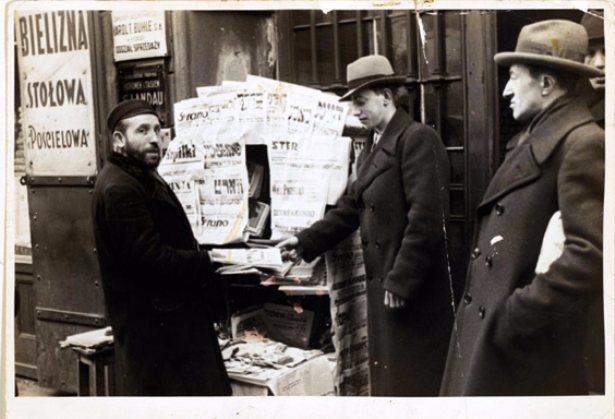
A Haynt newsstand in pre-War Poland
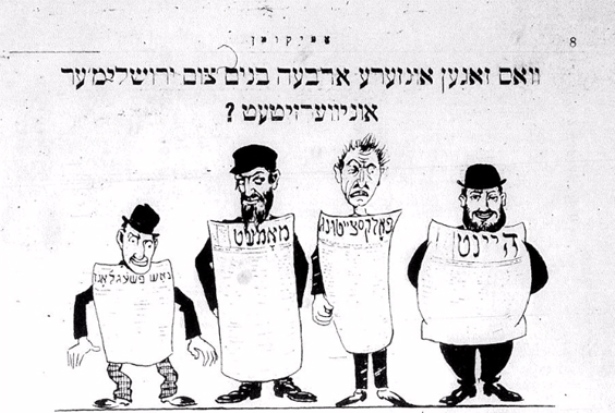
A cartoon of Haynt’s editors
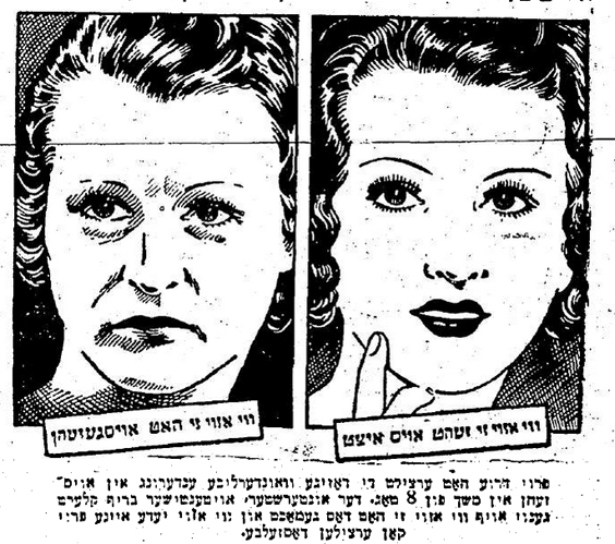
Womens’ interest articles and ads were well covered
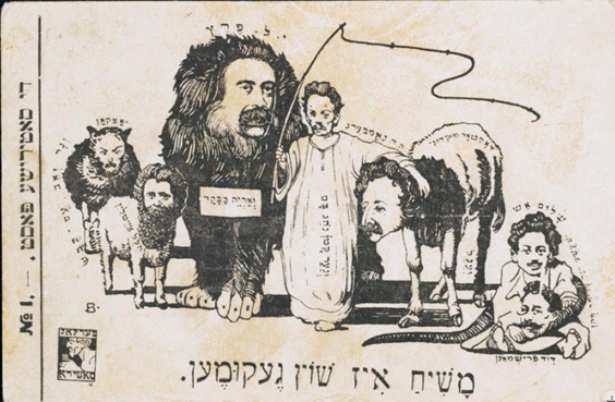
Cartoons such as this one representing the coming of the Moshiach show the age-old tolerance of Jewry





